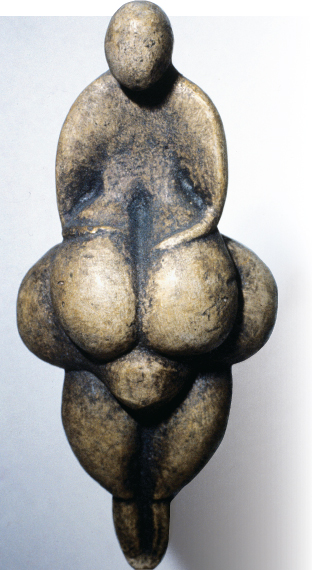From the First Hominids to the Paleolithic Era
Sometime between 7 and 6 million years ago in southern and eastern Africa, groups of human ancestors (members of the biological “hominid” family) began to walk upright, which allowed them to carry things. About 3.4 million years ago, some hominids began to use naturally occurring objects as tools, and around 2.5 million years ago, one group in East Africa began to make simple tools, a feat that was accompanied by, and may have spurred, brain development. Groups migrated into much of Africa and then into Asia and Europe; by about 600,000 years ago, there were hominids throughout much of Afroeurasia.
About 200,000 years ago, again in East Africa, some of these early humans evolved into Homo sapiens (“thinking humans”), which had still larger and more complex brains that allowed for symbolic language and better social skills. Homo sapiens invented highly specialized tools made out of a variety of materials. They made regular use of fire for heat, light, and cooking. They also migrated, first across Africa, and by 70,000 years ago, out of Africa into Eurasia. Eventually they traveled farther still, reaching Australia using rafts about 50,000 years ago and the Americas by about 15,000 years ago, or perhaps earlier. Gradually other types of hominids became extinct, leaving homo sapiens as the only survivors and the ancestors of all modern humans.
In the Paleolithic period, humans throughout the world lived in ways that were similar to one another. Archaeological evidence and studies of modern foragers suggest that people generally lived in small groups of related individuals and moved throughout the landscape in search of food. They ate mostly plants, and much of the animal protein in their diet came from foods gathered or scavenged rather than hunted directly. Paleolithic peoples did, however, hunt large game, often hunting in groups.
Paleolithic people were not differentiated by wealth. Most foraging societies that exist today, or did so until recently, have some type of division of labor by sex and also by age. Men are more often responsible for hunting and women for gathering plant and animal products. This may or may not have been the case in the Paleolithic era, or there may have been a diversity of patterns.
Beginning in the Paleolithic era, human beings have expressed themselves through what we would now term the arts or culture: painting and decorating walls and objects, making music, telling stories, dancing alone or in groups. Burials, paintings, and objects suggest that people may have developed ideas about supernatural forces that controlled some aspects of the natural world and the humans in it, what we now term spirituality or religion. Spiritually adept men and women communicated with that unseen world, and objects such as carvings or masks were probably thought to have special healing or protective powers. (See “Picturing the Past: Paleolithic Venus Figures.”)

CONNECTIONS: Some scholars see Venus figures as evidence that Paleolithic society was egalitarian or female-